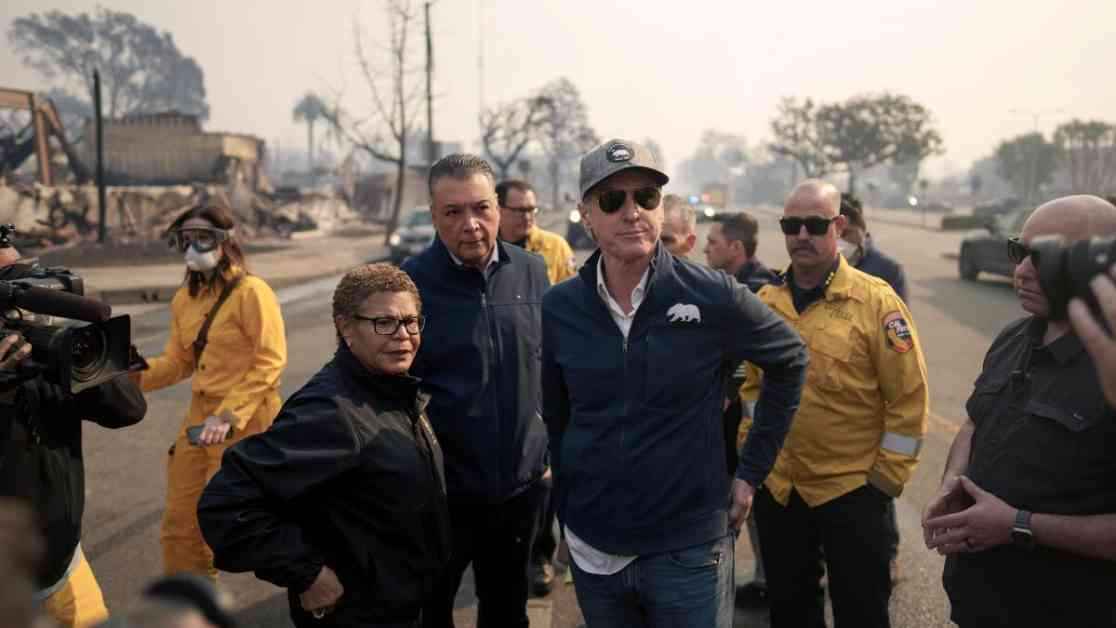California Governor Gavin Newsom is urging Congress to allocate an additional $39.7 billion in aid to assist Los Angeles in recovering from the devastating January firestorm. This move comes in light of the firestorm being projected as potentially the costliest natural disaster in U.S. history, with estimates of total economic losses exceeding $250 billion.
In a letter addressed to key figures in the House of Representatives, including House Speaker Mike Johnson, House Minority Leader Hakeem Jeffries, and Rep. Rosa DeLauro, Newsom emphasized the urgent need for federal support in helping Los Angeles rebuild and flourish post-disaster. The damage caused by the fires ravaged over 16,000 structures across 37,400 acres in areas like Pacific Palisades, Malibu, Pasadena, and Altadena.
Newsom’s detailed request outlines a strategic allocation of funds to various sectors, including rebuilding homes, infrastructure, businesses, schools, churches, and healthcare facilities. The proposed aid package aims to address the diverse needs of residents, workers, and children affected by the catastrophic fires, ensuring a comprehensive recovery plan for Los Angeles.
One of the major components of the funding request is $16.8 billion from the Federal Emergency Management Agency (FEMA) for property and infrastructure reconstruction, with an additional $5 billion designated for debris cleanup. Newsom also seeks $9.9 billion from the Department of Housing and Urban Development for grants to fire victims, homeowners, renters, and businesses, along with $5.29 billion from the Small Business Administration for homeowner and business loans.
Acknowledging the collaborative efforts of the Trump administration in expediting fire debris removal and facilitating recovery initiatives, Newsom expressed gratitude for the support received, emphasizing the importance of working together for Los Angeles’ long-term resilience and growth. The letter refrains from delving into potential disputes over federal aid conditions, focusing instead on the shared goal of rebuilding and revitalizing the city.
However, the approval of these funding requests hinges on bipartisan cooperation and a willingness to navigate potential challenges. Republican lawmakers face the decision of allocating funds amidst a backdrop of budget cuts, while Democratic counterparts must consider any associated conditions that could impact state policies. The ongoing debate over aid conditions reflects a broader political landscape where financial assistance intersects with policy objectives at both federal and state levels.
Notably, discussions surrounding potential aid conditions have surfaced, with proposals such as defunding the California Coastal Commission being considered as a means to streamline rebuilding efforts. The complex interplay of federal funding, policy considerations, and rebuilding priorities underscores the multifaceted nature of disaster recovery and resource allocation in the aftermath of catastrophic events.
In addition to the core funding requests, Newsom is advocating for supplementary allocations to address specific needs, including $432 million for water infrastructure, $350 million for wildfire resilience efforts on federal lands, and $101 million for transportation infrastructure. These targeted investments aim to bolster critical sectors and enhance community resilience in the face of future challenges.
The proposed increase in the Small Business Administration’s maximum loan limit for home reconstruction, from $500,000 to $2 million, reflects a strategic response to the unique rebuilding requirements in areas like Pacific Palisades. Rep. Brad Sherman, representing the affected region, has voiced support for this adjustment, citing its significance in facilitating the reconstruction of uninsured homes and meeting the evolving needs of the community.
As the debate over federal aid conditions continues, the fate of Los Angeles’ recovery efforts rests on the collaborative efforts of policymakers, stakeholders, and community members. The resilience and determination displayed in the face of adversity serve as a testament to the city’s spirit and commitment to rebuilding a stronger, more vibrant future. Through strategic funding allocations, policy initiatives, and community engagement, Los Angeles is poised to emerge from the aftermath of the firestorm with renewed strength and resilience, paving the way for a brighter tomorrow.


